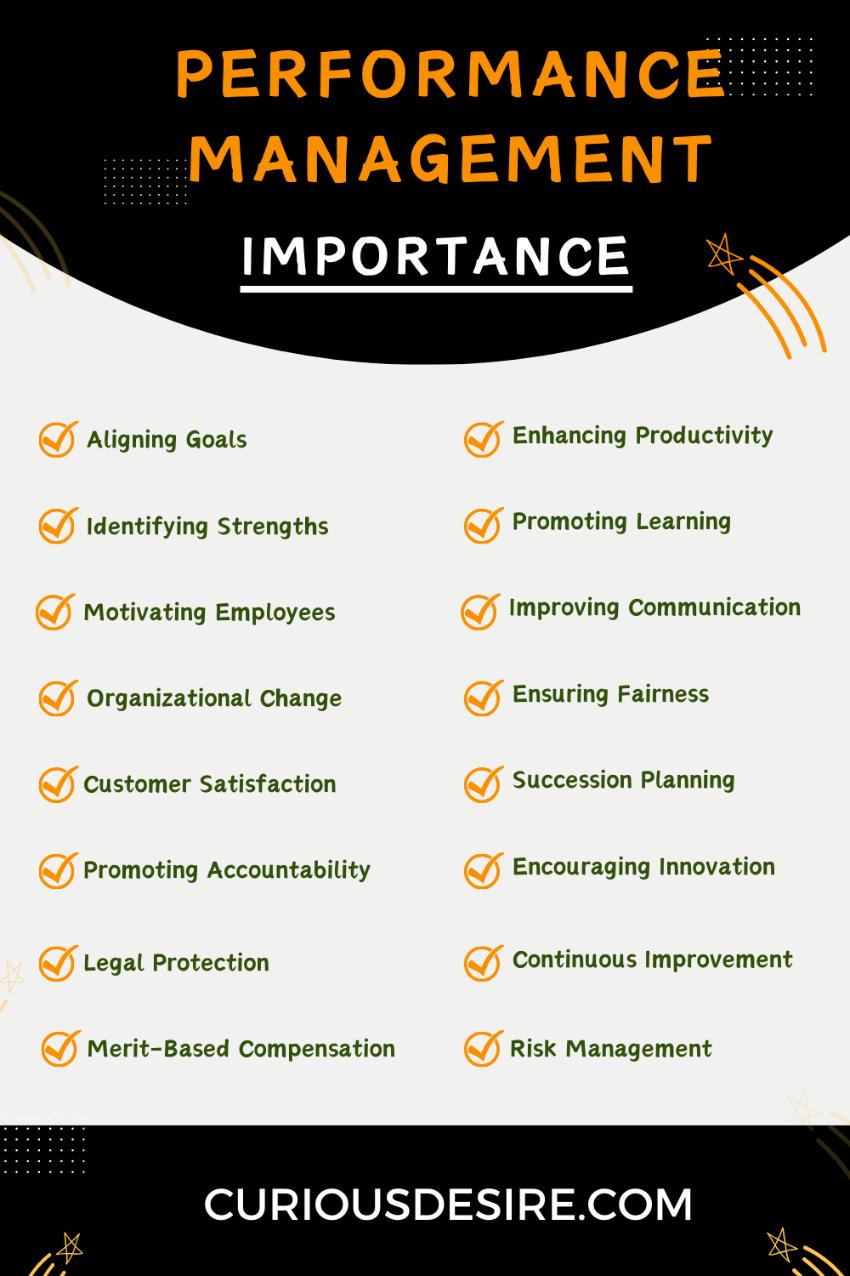Performance management is a vital component of organizational success, focusing on optimizing individual and team performance to achieve strategic goals.
It involves setting clear objectives, providing feedback, and aligning efforts with organizational objectives.
By promoting transparency and accountability, performance management enhances productivity, encourages employee engagement, and supports continuous improvement.
This article will discuss the essential role of performance management in driving organizational excellence and long-term success.
[toc]

1. Aligning Goals
Performance management ensures that individual and team objectives are in harmony with the broader organizational goals.
By clearly defining expectations and objectives, employees understand how their work contributes to the overall success of the organization.
This alignment encourages focus, direction, and a sense of purpose among employees, leading to increased motivation and productivity.
2. Enhancing Productivity
Clear performance expectations provide employees with a roadmap for success.
Regular feedback allows employees to understand their performance strengths and areas for improvement.
By identifying and addressing performance gaps, employees can refine their skills and work more efficiently, ultimately leading to improved productivity and performance outcomes.
3. Identifying Strengths and Weaknesses
Performance evaluations offer valuable insights into employees’ capabilities, strengths, and areas for development.
By recognizing and leveraging employees’ strengths, managers can optimize team performance and ensure that individuals are placed in roles that align with their skills and talents.
Addressing weaknesses through targeted training and development initiatives enhances employee competency and effectiveness in their roles.
4. Promoting Learning and Development
Performance management encourages a culture of continuous learning and improvement within the organization.
Feedback, coaching, and training programs enable employees to enhance their skills, acquire new knowledge, and adapt to evolving job requirements.
Investing in employee development not only strengthens individual capabilities but also enhances overall organizational agility and competitiveness in the marketplace.
5. Motivating Employees
Recognition of employees’ contributions and achievements reinforces desired behaviors and motivates them to excel in their roles.
Opportunities for advancement and career growth provide employees with a clear pathway for progression, incentivizing high performance and commitment to organizational goals.
Additionally, rewards and recognition programs serve as tangible expressions of appreciation, providing a positive work environment and boosting employee morale.
6. Improving Communication
Regular performance discussions provide open communication channels between managers and employees.
By providing constructive feedback and addressing concerns in a timely manner, managers can build trust and rapport with their teams.
Effective communication ensures that expectations are clear, goals are understood, and any obstacles to performance are promptly addressed, leading to enhanced collaboration and productivity.
7. Driving Organizational Change
Performance management enables organizations to adapt to changing business environments by identifying areas for improvement and innovation.
By analyzing performance data and identifying trends, organizations can make informed decisions and implement strategic initiatives to drive organizational change.
Performance management catalyzes continuous improvement, enabling organizations to stay agile and responsive to market dynamics.
8. Ensuring Fairness and Equity
Fair and transparent performance management processes promote a sense of fairness and trust among employees.
By establishing clear performance criteria and evaluation standards, organizations ensure that performance assessments are objective and unbiased.
Consistency in performance evaluations provides a culture of equity and meritocracy, where employees are recognized and rewarded based on their contributions and achievements.
9. Enhancing Customer Satisfaction
High-performing employees who consistently meet or exceed performance expectations directly contribute to positive customer experiences.
When customers receive excellent service or high-quality products, they are more likely to remain loyal and recommend the organization to others.
This loyalty not only boosts revenue but also strengthens the organization’s reputation in the market.
By aligning employee performance with customer satisfaction metrics, businesses can prioritize customer-centric practices and maintain a competitive edge.
10. Facilitating Succession Planning
Effective performance management enables organizations to identify and nurture high-potential employees for future leadership roles.
By evaluating both performance and potential, managers can pinpoint individuals with the necessary skills, competencies, and leadership qualities to succeed in key positions.
Succession planning ensures a smooth transition of leadership, minimizes disruptions to business operations, and mitigates risks associated with leadership gaps.
Moreover, investing in talent development and succession planning strengthens employee engagement, retention, and organizational stability over the long term.
11. Promoting a Culture of Accountability
When employees understand how their performance directly contributes to organizational success, they are more likely to feel motivated and empowered to excel in their roles.
Transparent communication channels, regular feedback, and performance-based rewards further reinforce accountability and encourage employees to align their efforts with strategic objectives.
Ultimately, a culture of accountability cultivates trust, collaboration, and a shared commitment to achieving collective goals across the organization.
12. Encouraging Innovation and Creativity
Performance management systems that value and reward innovation play a vital role in stimulating creativity and problem-solving among employees.
By recognizing and celebrating innovative contributions, organizations inspire employees to think outside the box, experiment with new ideas, and propose novel solutions to challenges.
Providing an environment where risk-taking is encouraged and failures are viewed as learning opportunities promotes a culture of innovation and adaptability.
Moreover, integrating innovation goals into performance objectives encourages employees to continuously seek improvements, drive organizational growth, and stay ahead in today’s rapidly changing business landscape.
13. Compliance and Legal Protection
Effective performance management systems help organizations comply with legal requirements and regulations governing performance evaluation, compensation, and employee rights.
By documenting performance discussions, setting clear expectations, and ensuring fair treatment of employees, organizations mitigate the risk of potential legal disputes or claims related to performance management practices.
Compliance with legal standards not only protects the organization from legal liabilities but also reinforces its commitment to ethical and responsible business practices.
14. Benchmarking and Continuous Improvement
Performance management enables organizations to benchmark performance against industry standards, competitors, or previous performance levels.
By analyzing key performance indicators (KPIs) and conducting comparative analysis, businesses can identify areas of strength and areas needing improvement.
This data-driven approach guides efforts to continuously enhance performance, innovate processes, and remain competitive in the market.
Moreover, having a culture of continuous improvement empowers employees at all levels to contribute ideas, experiment with new approaches, and collaborate on initiatives that drive organizational excellence and customer satisfaction.
15. Supporting Merit-Based Compensation
Performance management systems often serve as the foundation for determining merit-based compensation, bonuses, and other rewards.
Linking pay to performance aligns employees’ efforts with organizational goals, incentivizes high performance, and reinforces desired behaviors and outcomes.
By transparently communicating the connection between individual contributions and rewards, organizations motivate employees to strive for excellence and take ownership of their performance.
Moreover, merit-based compensation fosters a fair and equitable work environment, where employees feel recognized and rewarded for their hard work, talent, and dedication.
This, in turn, enhances morale, motivation, and overall job satisfaction across the workforce.
16. Risk Management
Performance management plays a crucial role in identifying and mitigating various risks associated with employee performance.
Through regular performance evaluations and feedback mechanisms, managers can detect issues such as underperformance, skill gaps, or compliance concerns early on.
Addressing these challenges proactively minimizes the likelihood of costly errors, regulatory violations, or damage to the organization’s reputation.
Importance Of Performance Management FAQs
1. What are the 5 elements of performance management?
- Goal Setting: Establishing clear and measurable goals that align with organizational objectives.
- Performance Planning: Developing strategies and action plans to achieve the set goals effectively.
- Performance Monitoring: Regularly tracking and assessing progress towards goals, identifying any deviations or areas for improvement.
- Feedback and Coaching: Providing constructive feedback to employees on their performance and offering support and guidance to help them improve.
- Performance Review: Conduct formal evaluations to assess employee performance, recognize achievements, and identify development needs.
2. Why is performance management important?
Performance management is crucial for several reasons:
- It aligns individual and team goals with organizational objectives.
- It enhances productivity and efficiency by setting clear expectations and providing feedback.
- It identifies strengths and weaknesses, supporting talent development and succession planning.
- It promotes learning and development, fostering employee growth and career advancement.
- It motivates employees, recognizing and rewarding good performance while providing opportunities for advancement.
3. What are the 6 purposes of performance management?
- Clarifying Expectations: Performance management ensures employees understand what is expected of them and how their work contributes to organizational goals.
- Improving Performance: By providing feedback and support, performance management helps employees enhance their skills and capabilities to perform at their best.
- Facilitating Communication: Regular performance discussions foster open communication between employees and managers, addressing concerns and building stronger relationships.
- Supporting Decision Making: Performance data and evaluations inform decision-making processes related to talent management, resource allocation, and strategic planning.
- Recognizing and Rewarding Achievement: Performance management systems often include rewards and recognition programs to acknowledge and reinforce desired behaviors and outcomes.
- Driving Continuous Improvement: Performance management encourages a culture of continuous learning and improvement, enabling organizations to adapt and thrive in changing environments.
4. Why is reward important in performance management?
Reward is important in performance management for several reasons:
- It motivates employees to perform at their best by recognizing and reinforcing desired behaviors and outcomes.
- It helps attract and retain top talent by offering competitive compensation and incentives for high performance.
- It fosters a positive work environment and enhances employee morale, engagement, and job satisfaction.
- It aligns employee efforts with organizational goals and values, promoting a culture of performance and accountability.
- It supports talent development and succession planning by identifying and rewarding high-potential individuals for advancement opportunities.

